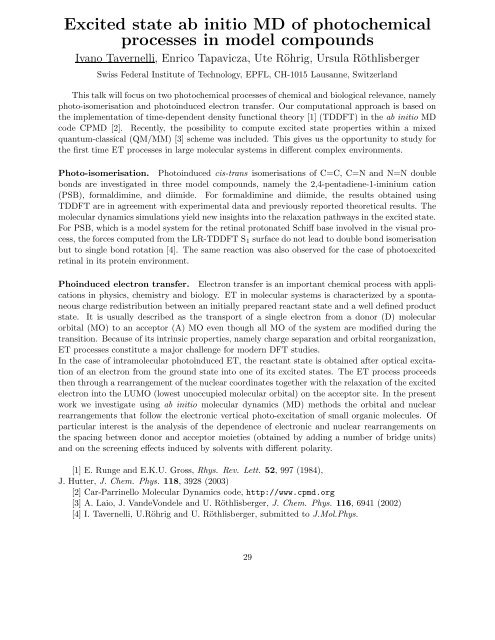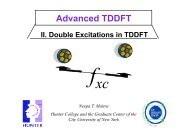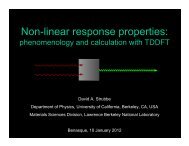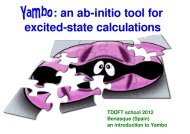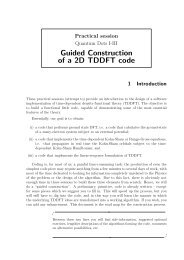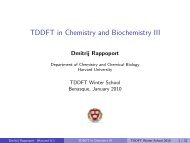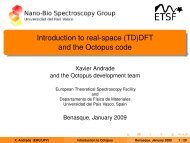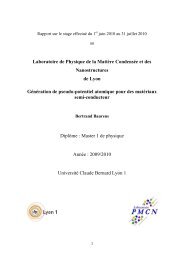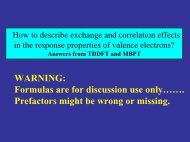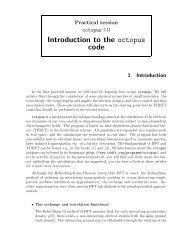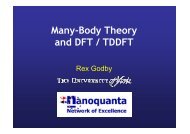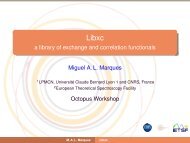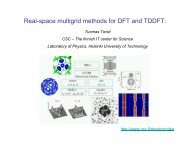TIME DEPENDENT DENSITY FUNCTIONAL THEORY ... - TDDFT.org
TIME DEPENDENT DENSITY FUNCTIONAL THEORY ... - TDDFT.org
TIME DEPENDENT DENSITY FUNCTIONAL THEORY ... - TDDFT.org
- No tags were found...
Create successful ePaper yourself
Turn your PDF publications into a flip-book with our unique Google optimized e-Paper software.
Excited state ab initio MD of photochemical<br />
processes in model compounds<br />
Ivano Tavernelli, Enrico Tapavicza, Ute Röhrig, Ursula Röthlisberger<br />
Swiss Federal Institute of Technology, EPFL, CH-1015 Lausanne, Switzerland<br />
This talk will focus on two photochemical processes of chemical and biological relevance, namely<br />
photo-isomerisation and photoinduced electron transfer. Our computational approach is based on<br />
the implementation of time-dependent density functional theory [1] (<strong>TDDFT</strong>) in the ab initio MD<br />
code CPMD [2]. Recently, the possibility to compute excited state properties within a mixed<br />
quantum-classical (QM/MM) [3] scheme was included. This gives us the opportunity to study for<br />
the first time ET processes in large molecular systems in different complex environments.<br />
Photo-isomerisation. Photoinduced cis-trans isomerisations of C=C, C=N and N=N double<br />
bonds are investigated in three model compounds, namely the 2,4-pentadiene-1-iminium cation<br />
(PSB), formaldimine, and diimide. For formaldimine and diimide, the results obtained using<br />
<strong>TDDFT</strong> are in agreement with experimental data and previously reported theoretical results. The<br />
molecular dynamics simulations yield new insights into the relaxation pathways in the excited state.<br />
For PSB, which is a model system for the retinal protonated Schiff base involved in the visual process,<br />
the forces computed from the LR-<strong>TDDFT</strong> S 1 surface do not lead to double bond isomerisation<br />
but to single bond rotation [4]. The same reaction was also observed for the case of photoexcited<br />
retinal in its protein environment.<br />
Phoinduced electron transfer. Electron transfer is an important chemical process with applications<br />
in physics, chemistry and biology. ET in molecular systems is characterized by a spontaneous<br />
charge redistribution between an initially prepared reactant state and a well defined product<br />
state. It is usually described as the transport of a single electron from a donor (D) molecular<br />
orbital (MO) to an acceptor (A) MO even though all MO of the system are modified during the<br />
transition. Because of its intrinsic properties, namely charge separation and orbital re<strong>org</strong>anization,<br />
ET processes constitute a major challenge for modern DFT studies.<br />
In the case of intramolecular photoinduced ET, the reactant state is obtained after optical excitation<br />
of an electron from the ground state into one of its excited states. The ET process proceeds<br />
then through a rearrangement of the nuclear coordinates together with the relaxation of the excited<br />
electron into the LUMO (lowest unoccupied molecular orbital) on the acceptor site. In the present<br />
work we investigate using ab initio molecular dynamics (MD) methods the orbital and nuclear<br />
rearrangements that follow the electronic vertical photo-excitation of small <strong>org</strong>anic molecules. Of<br />
particular interest is the analysis of the dependence of electronic and nuclear rearrangements on<br />
the spacing between donor and acceptor moieties (obtained by adding a number of bridge units)<br />
and on the screening effects induced by solvents with different polarity.<br />
[1] E. Runge and E.K.U. Gross, Rhys. Rev. Lett. 52, 997 (1984),<br />
J. Hutter, J. Chem. Phys. 118, 3928 (2003)<br />
[2] Car-Parrinello Molecular Dynamics code, http://www.cpmd.<strong>org</strong><br />
[3] A. Laio, J. VandeVondele and U. Röthlisberger, J. Chem. Phys. 116, 6941 (2002)<br />
[4] I. Tavernelli, U.Röhrig and U. Röthlisberger, submitted to J.Mol.Phys.<br />
29


